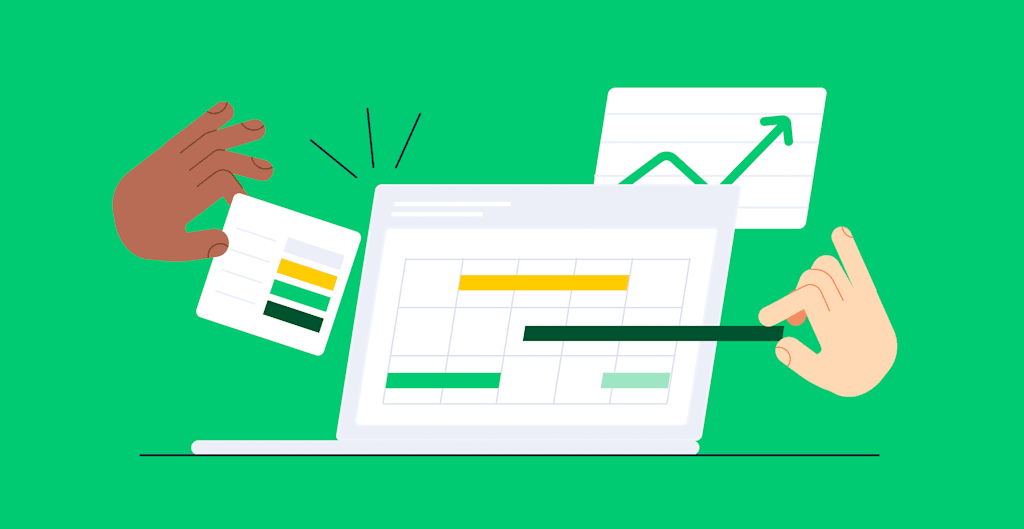Successful products are never static. They evolve to meet the needs of customers and the overall market. Take Coca-Cola as an example. Pharmacist John Pemberton’s original 1885 recipe contained cocaine, a legal medicinal ingredient that wasn’t controversial at the time. However following health concerns and regulatory change, the cocaine was replaced with caffeine as a stimulant.
Since then, the brand has developed its iconic bottle shape and introduced spin-offs like Diet Coke and Coke Zero, enabling the product to grow and change over the years.
Managing the evolution of your products can be daunting, which is where product roadmaps come into play. This guide explores how product roadmap software keeps you organized and explores the best options available in 2025.
What is product roadmap software?
Product roadmap software allows product managers and related teams to plan, communicate, and track the development and progress of their products over time. Your tool of choice visually represents your strategy and goals, outlining the key features, milestones, and timelines involved in delivering a successful product.
If the market changes or customer demands shift, quality software will enable you to update your roadmap, informing key stakeholders of any changes and keeping everyone on the same page.
The best product roadmap software for 2025
With plenty of choice in the market, it can be challenging to pick the best product roadmap software for your needs. To give you a kickstart, here are three popular options, complete with relevant G2 customer ratings to narrow down your choice.
1. monday dev
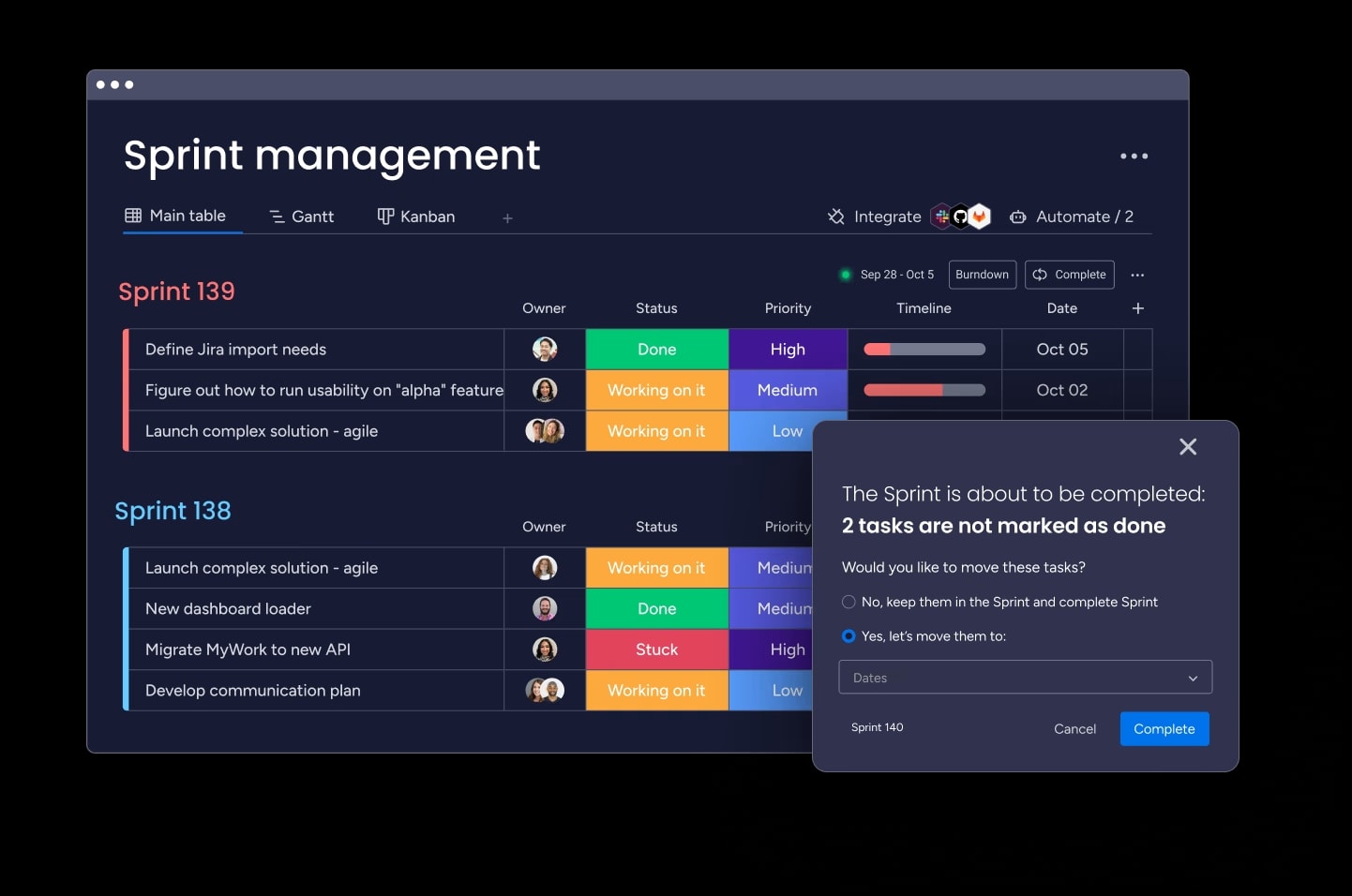
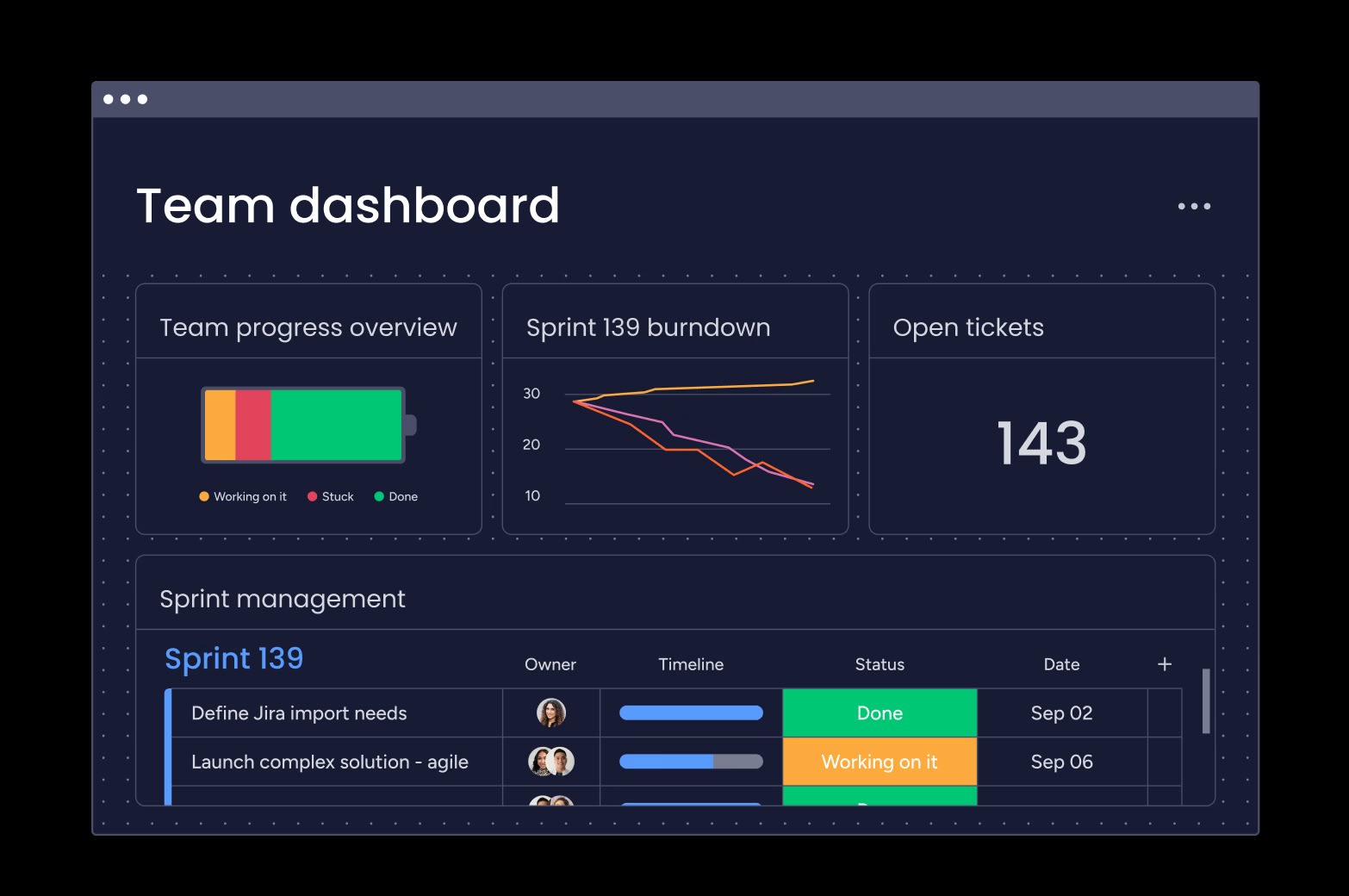
| Best for: Agile teams of any size |
| Top features: - Sprint management - Git Integration - Kanban view, Burndown chart - Automations & AI-tools Pricing: Free trial available. Plans starting from $10/user/month See all monday.com pricing plans Try monday dev |
2. Jira Product Discovery
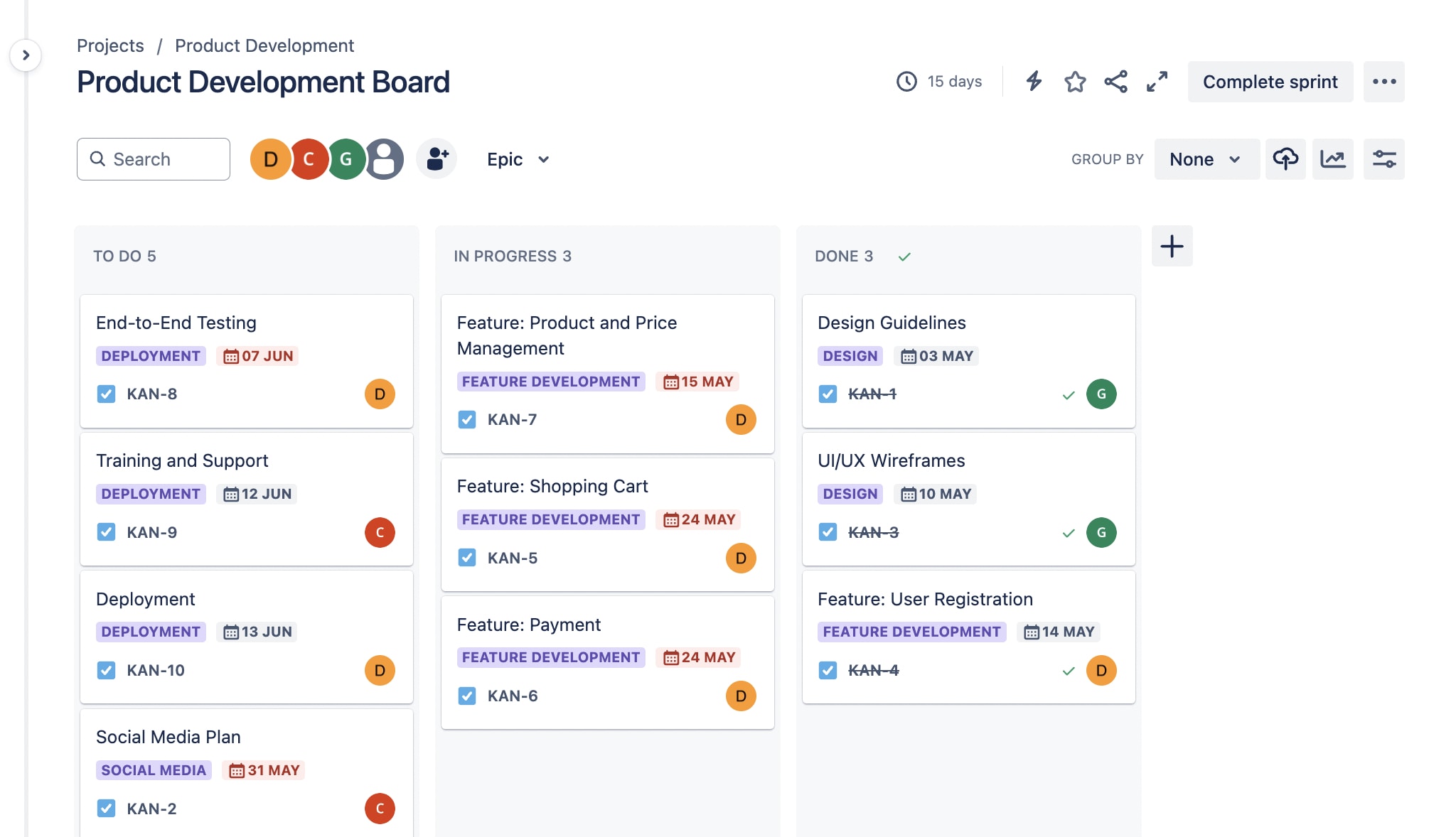
| Best for: Saas and app product development |
| Top features: - Bug tracking and reporting - Roadmap feature - Scrum & Kanban views - GitHub integration and more Pricing Free plan available. Plans starting from $10 per user/month Read full review: Jira Review |
3. Clickup

| Best for: Software development |
| Top features: - Agile dashboards - Kanban & Scrum boards - Sprint backlogs & issue tracking - Product roadmap - Automation tools Pricing Free plan available. Plans starting from $7/user/month Read full review: Clickup Review |
4. Aha!
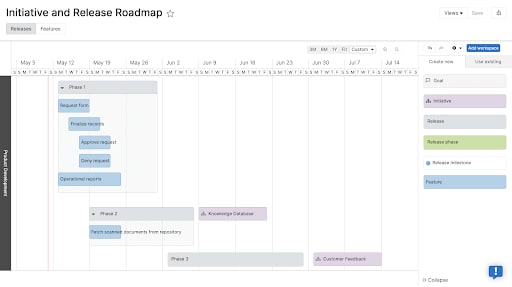
Best for: Product management teams
Top features:
- Idea management
- Purpose-built whiteboards
- Visual roadmaps
- Integrations
Pricing:
- 30-day free trial available.
- Pricing plans based on use case, starting at $9/user/month
Read the full Aha! review, and Aha vs competitors
5. Azure Devops
Best for: Developers and PMs building software
Top features:
- Continuous integration and deployment
- Agile project management
- Dashboards
- API integration
Pricing:
- Basic plan with 5 free users.
- Starting at $6/user/month above 5 users
6. Linear
Best for: Developers and product management looking to collaborate
Top features:
- Cycles for sprints
- Issue tracking
- Roadmaps
Pricing:
- Free plan available
- Paid plans starting at $8/user/month
Read the full Linear review, and Linear vs competitors
7. ProductBoard
Best for: Product managers looking to gather insights
Top features:
- Prioritization
- Road mapping and roadmap filtering
- Consolidating feedback
- Product hierarchy
Pricing:
- Free starter plan
- Paid plans starting at $19/user/month
For more: Read our blog on Productboard alternatives
8. ProductPlan
Best for: Teams who want to build product strategy
Top features:
- Prioritization
- Unlimited roadmaps
- Collaboration options
Pricing:
Not listed publicly
For more: Read our blog on ProductPlan alternatives
9. Miro
Best for: Teams looking to build product roadmaps visually
Top features:
- Brainstorming and ideation
- Diagramming
- Online sticky notes
- Flowchart maker
Pricing:
- Free plan available
- Paid plans starting at $8/user/month
10. Asana
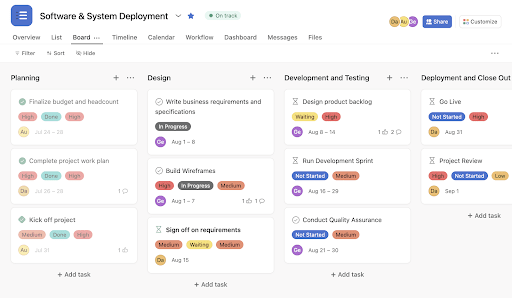
Best for: Project management together with roadmap building
Top features:
- Project views
- Task management
- Analysis tools
Pricing:
- Free personal plan
- Starter plan starting at $10.99/user/month
Read the full Asana review
11. Wrike
Best for: Project management and collaboration
Top features:
- Multiple work views
- Reports and analytics
- Workflow automation and Gen AI
Pricing:
- Free plan available
- Team plan starting at $9.80/user/month
Read the full Wrike review
Why use software for a product roadmap?
Product roadmaps come in different shapes and sizes, including manually-designed paper or spreadsheet versions if that’s your preference. But there are multiple advantages to using a dedicated tool, including the following:
Visual representation
Product roadmap software is fully equipped with visual tools that allow you to create a clear and engaging representation of your roadmap. This visualization provides an easily digestible format for communicating strategy, milestones, and project progress to your stakeholders, team members, and customers.
Enhanced decision-making
The right product roadmap tool will elevate your decision-making with detailed insights. You can easily view correlations, analyze data, and spot potential bottlenecks to make the right calls quickly.
Consistent communication
Using the same tool or even a tailored roadmap template each time creates standardization for every product you develop. This consistent approach is crucial for larger organizations where different teams or departments might work on a product’s interconnected aspects. You want them to be familiar with how to use the roadmap each time they interact with it.
How does product roadmap software benefit your internal teams?
The product roadmap (sometimes referred to as a product plan roadmap) touches all teams within an organization, including the following:
- Product development teams are guided by their single source of truth, visualizing and communicating product goals and strategy to the rest of the development team.
- Marketing and sales teams use the roadmap to develop consistent messaging across each marketing channel, and stay abreast of feature launches or campaigns.
- Executive teams rely on roadmaps for strategic planning and decision-making.
- Customer success teams glean valuable insights from the platform, allowing them to align support and outreach efforts with upcoming product milestones to ensure a positive customer experience.
- Finance teams refer to roadmaps to accurately budget for product development and track ROI.
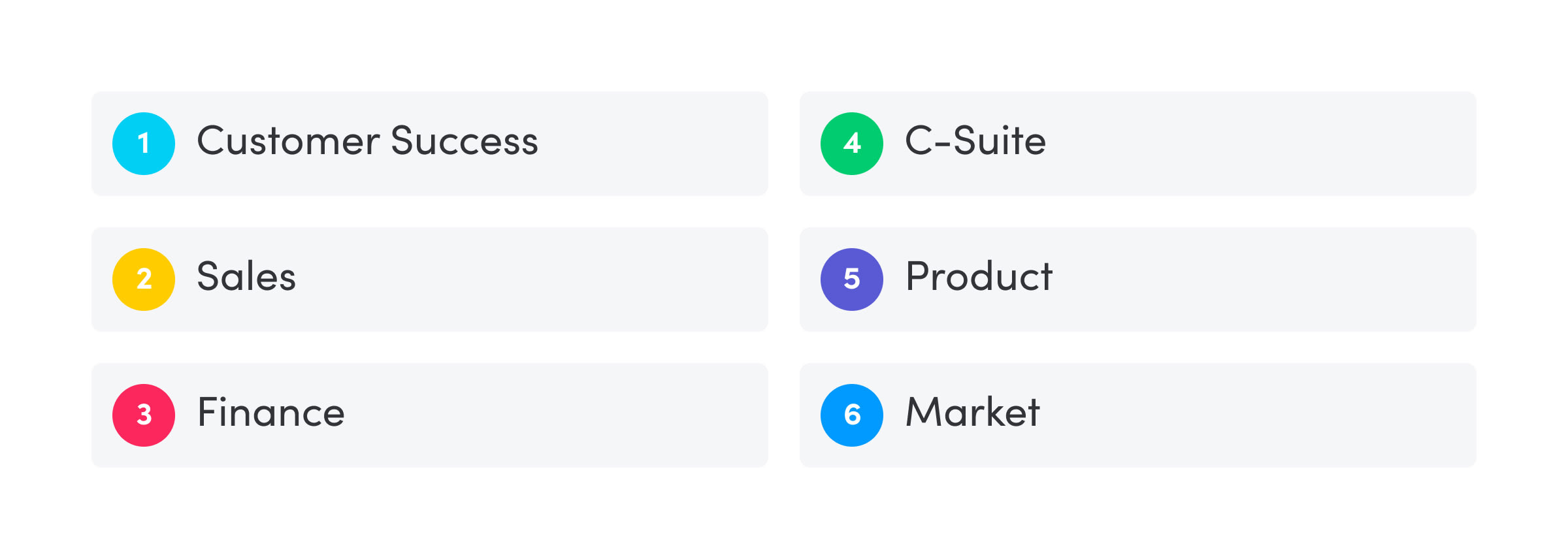
What to look for in product roadmap software
There’s no such thing as generic product roadmap software; each tool has unique features and functionality that may appeal (or not) to your organization. It’s easy to get swamped in the details, but if you need to whittle down the choice, focus on the following elements, which are all available on monday dev.
- Customization: No two products or product teams are alike. You’ll want the ability to tailor your dashboard, workflow, and views according to your needs. For example, monday dev enables you to view your product data in a range of views, including Kanban, Gantt, Workload, or combine up to 50 boards to create a customized dashboard. We also offer a product roadmap template to give you a headstart.
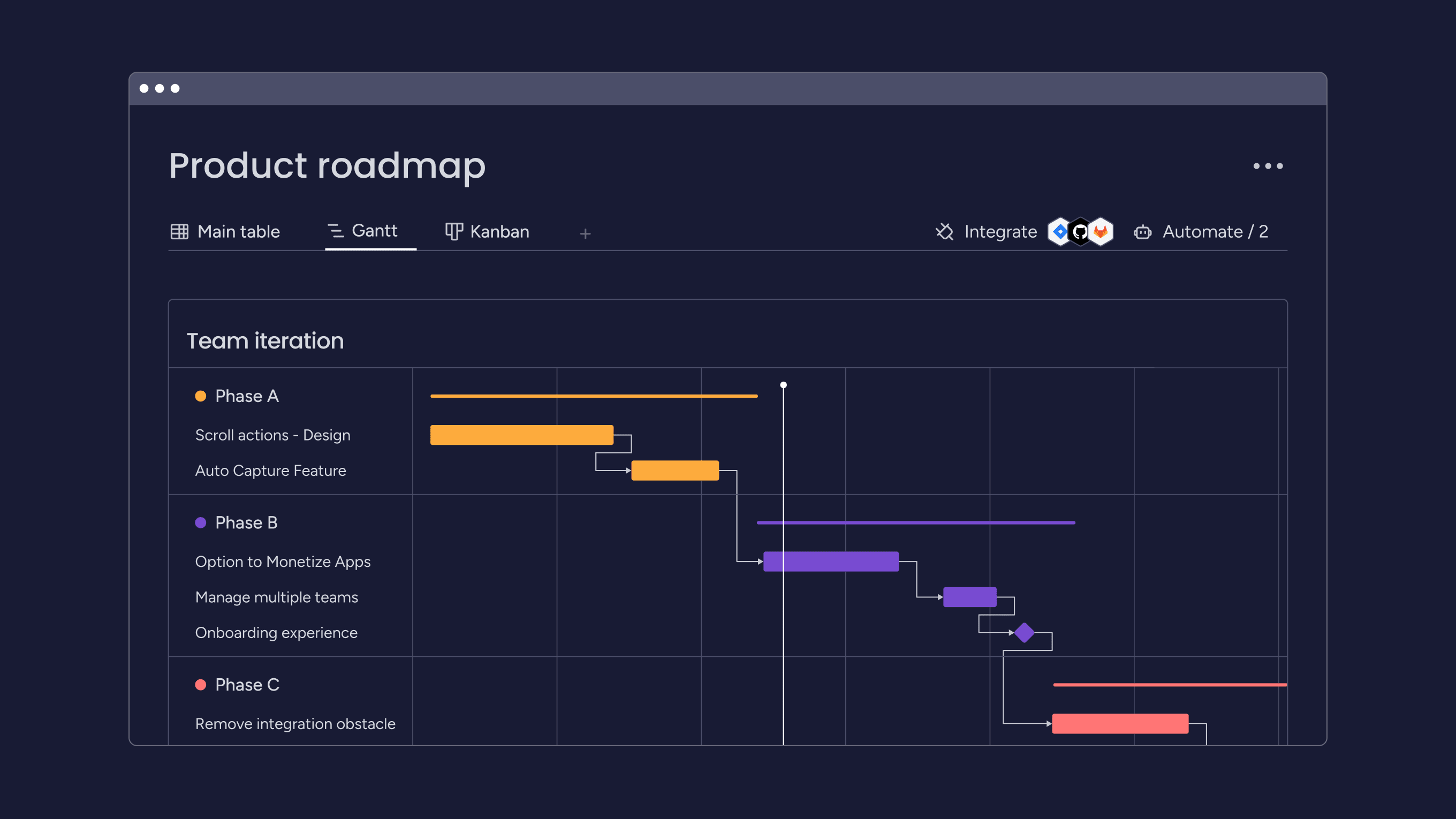
- Integration: To manage your product from a single location, your software should be able to sync up with other key tools in your tech stack. For example, you might want to pull in data from spreadsheets, coding tools or messaging platforms. monday dev integrates seamlessly with 72+ other platforms, including GitHub, GitLab, Figma, Slack, and many others to keep you connected to the tools you already love.
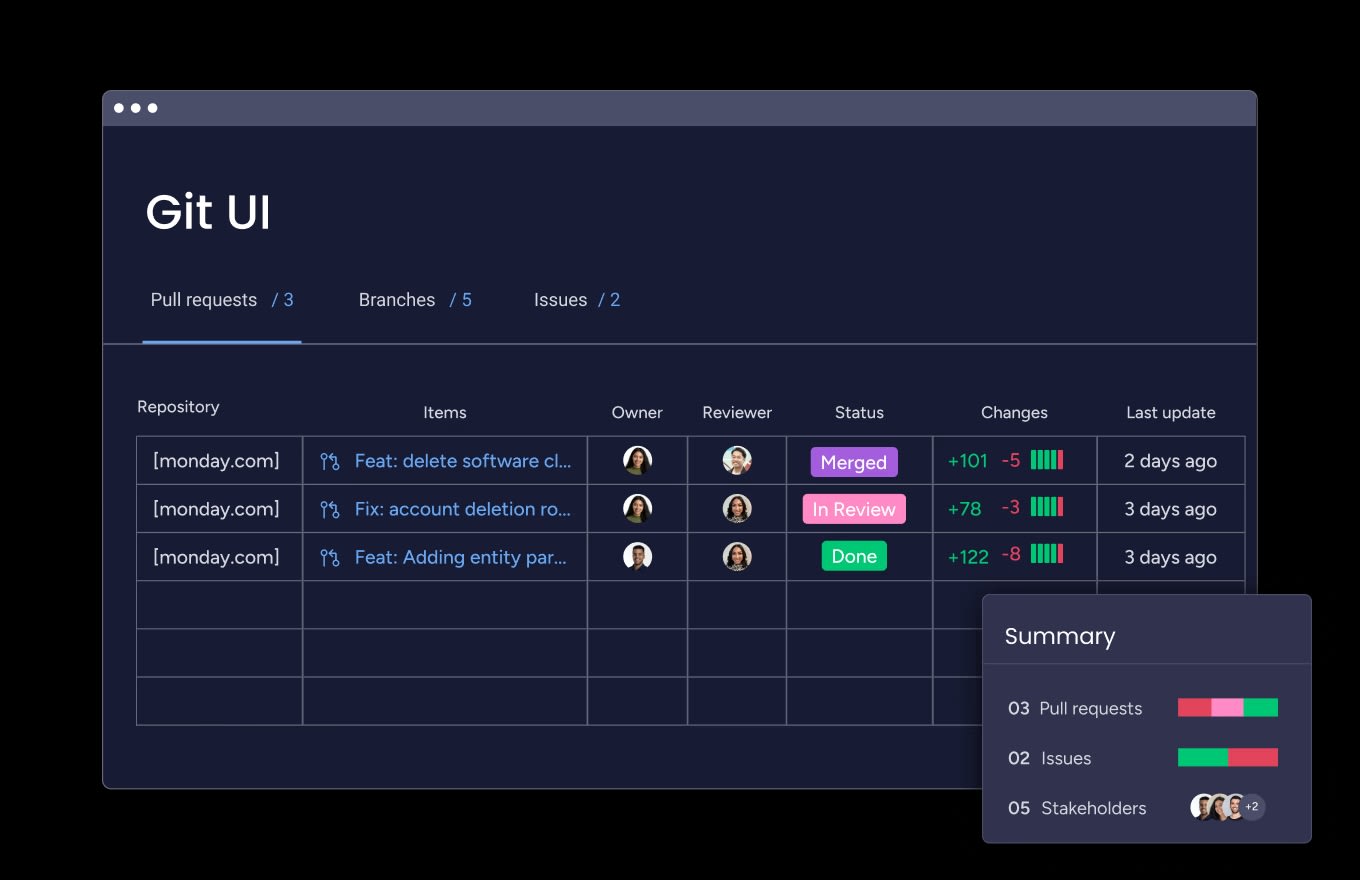
- Progress tracking: As products progress, change direction, or morph into another creation entirely, your roadmap needs to keep pace. Choose a tool that allows you to update and track progress easily so everyone stays on the same page. monday dev allows you to set statuses, check milestones, and incorporate feedback for continuous improvements. This real-time updating and tracking ensures your product development is agile and responsive to change.

- Collaboration: Product development involves many moving parts and strong collaboration across multiple teams. Your roadmap software should be a central hub for providing updates, making contributions, and brainstorming ideas in real-time. monday dev is a cloud-based solution that allows distributed team members from anywhere to access and collaborate on your product roadmap platform 24/7. With monday dev, it’s easy to assign relevant tasks to team members, add comments to board items, or share collective knowledge in monday docs.
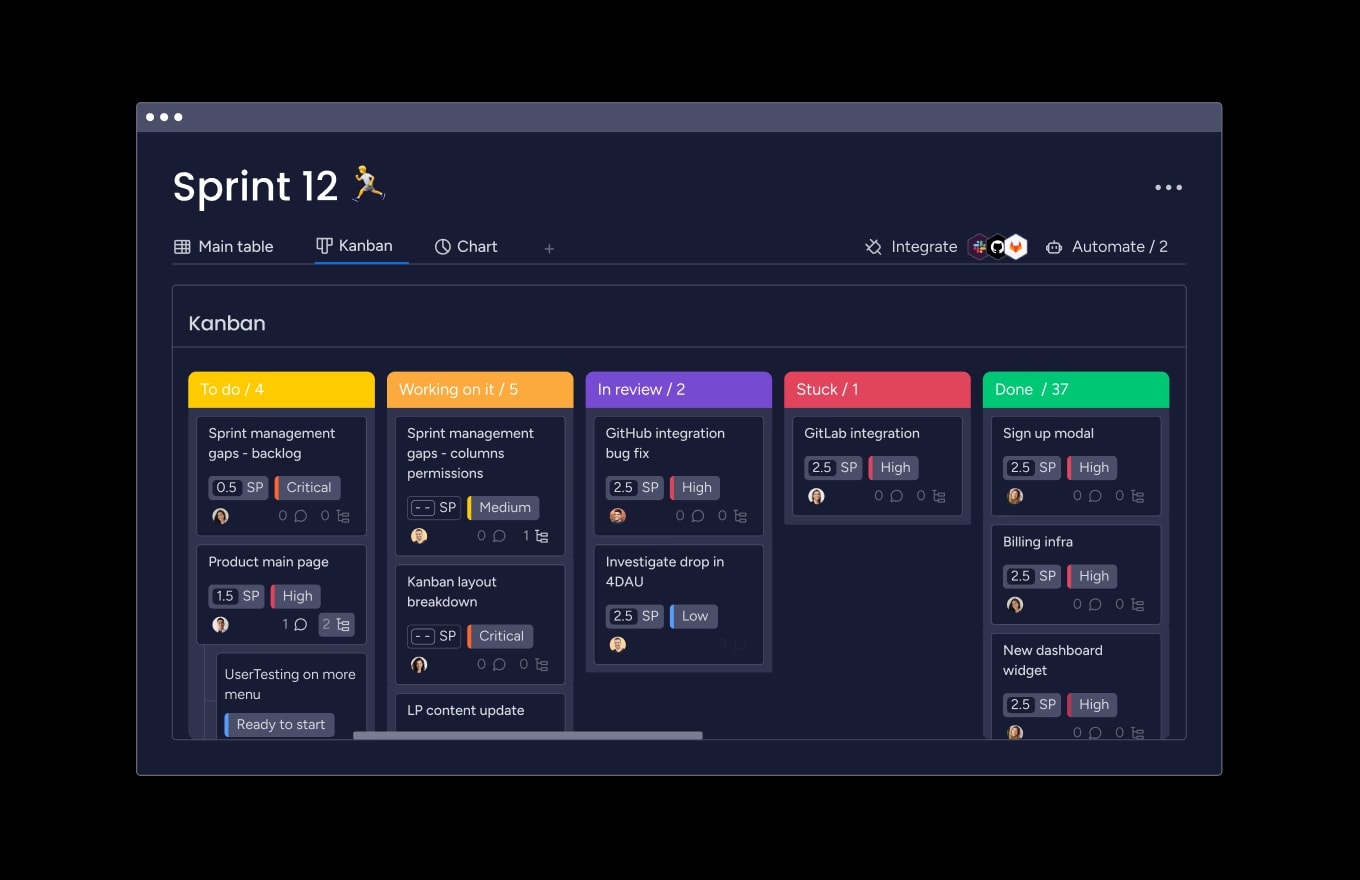
- Automation: Building and updating a product roadmap involves countless repetitive tasks that eat into your time. monday dev features advanced automation recipes and integrations. These custom triggers and actions automate routine tasks so you can concentrate on delivering your product with speed and precision. For example, you might set up an automation that sends an email notification to your marketing team when you update your roadmap with new product launch details.
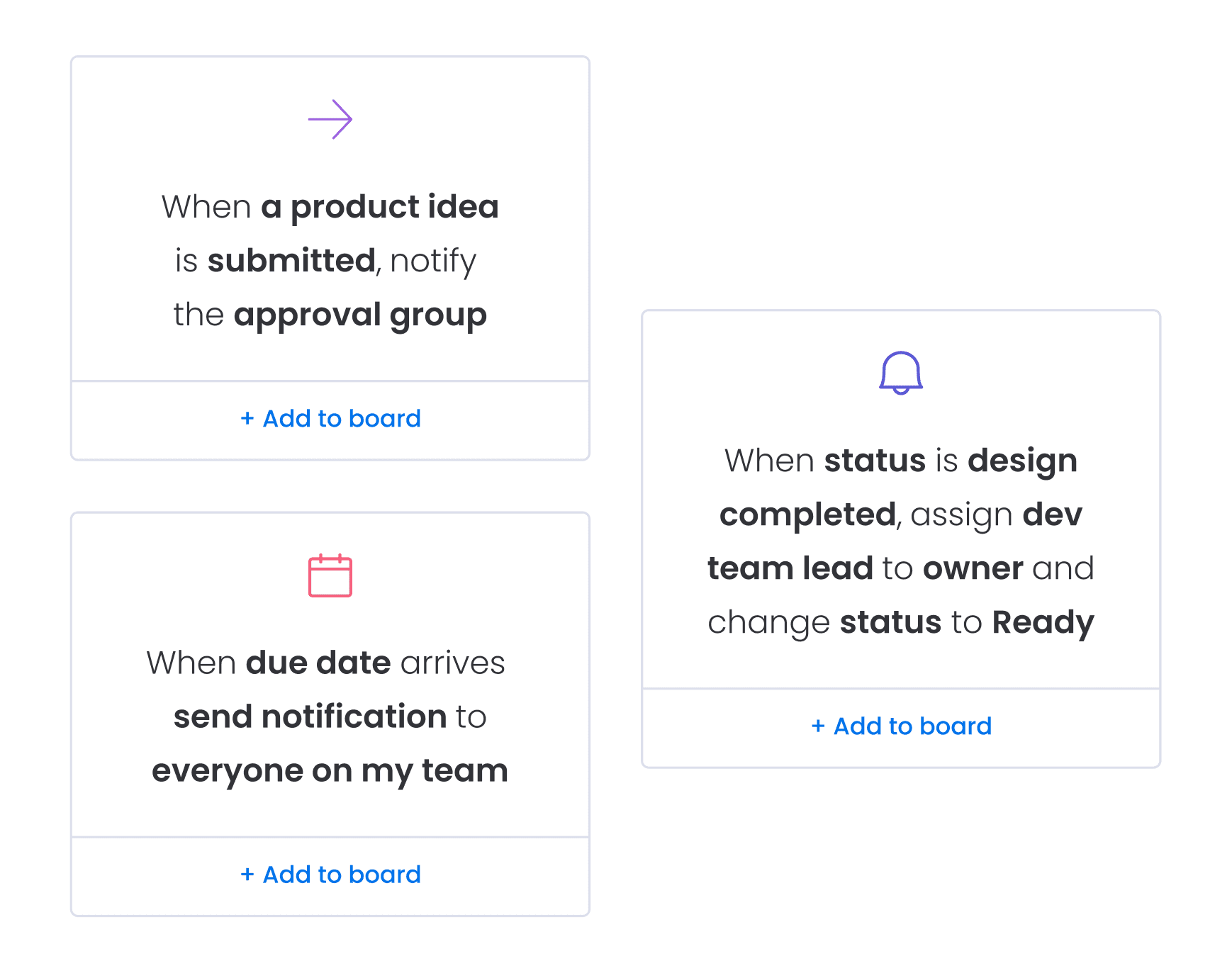
How to create a product roadmap in 6 steps
While the process of building a product roadmap example differs depending on the team and the type of product, general steps often look like this:
Step 1: Define the vision and goal of a product. Teams work together to understand the team and company vision and how they come together to meet customer needs.
Step 2: Understand how each product and feature meets company goals. Look at the potential new product to make sure it is moving the company in the right direction.
Step 3: Build initial roadmaps. This should be high level.
Step 4: Create themes based on your strategy. This will help keep your roadmap organized and help you understand how the roadmap meets product strategy goals.
Step 5: Determine scope and goals. This is a critical step to make sure your roadmap is realistic. It will general include back-and-forth between teams and team members who have differing opinions on priorities and timelines.
Step 6: Be ready to make changes in the roadmap. No roadmap is ever 100% accurate. Be ready to change over time to create the best product possible.
monday dev: A flexible product roadmap software for your teams
Product roadmap software is the shining light that shows every team within the organization how to get from point A to point B. With multiple solutions in the market, monday dev stands out as the product roadmap software your teams need to stay aligned and constantly driving forward. Take a free demo today to explore the full potential of our platform.
FAQs
How do I create a product roadmap?
To create a product roadmap, first select your preferred software, then follow these steps:
Gather all necessary information, including product goals and strategies, milestones, and progress updates.
Use your software’s visualization tools to create a clear and engaging representation of your roadmap.
Add relevant details, such as correlations or data analysis, to help with decision-making.
Share the roadmap with stakeholders, teams, and departments for feedback and collaboration.
Continuously update and track progress to ensure your roadmap reflects the latest developments.
How often should a product roadmap be updated?
Update your product roadmap frequently as changes occur in the development process. This could range from daily updates to weekly or monthly reviews, depending on the size and complexity of your project. It's important to keep all stakeholders informed about any major changes or shifts in strategy to maintain alignment and transparency across the organization.
What is the best tool for a product roadmap?
The best tool for your product roadmap depends on your budget and the specific features you require from the software. monday dev is a fully customizable tool that will produce a bespoke roadmap for your organization.
 Get started
Get started 

